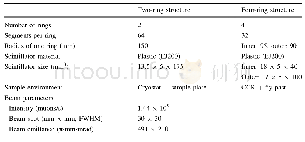《Table 2 Errors of parameters in theΛCDM, w CDM, and CPL models for the fits to the H (z) , H (z) +W
 提示:宽带有限、当前游客访问压缩模式
提示:宽带有限、当前游客访问压缩模式
本系列图表出处文件名:随高清版一同展现
《Prospect for Cosmological Parameter Estimation Using Future Hubble Parameter Measurements》
The 68.3%and 95.4%CL posterior distribution contours are shown.The data combinations used are the H(z)data,the H(z)+WFIRST data,and the H(z)+WFIRST+E-ELT data,and their constraint results are shown with white,red,and blue contours,respectively.The 1σerrors of the parameters w0,wa,?m,and h for the three models for the above three data combinations are given in Table 2.It is shown that the current H(z)data could provide fairly good constraints on these typical dark energy models.With the H(z)+WFIRST observation,the constraints on?mand h will be improved,respectively,by 35.6%and 14.3%for theΛCDM model,by 34.7%and5.7%for the w CDM model,and by 19.3%and 5.0%for the CPL model.With the H(z)+WFIRST+E-ELT observation,the constraints on?mand h will be further improved by 81.9%and 57.1%for theΛCDM model,by 78.7%and41.9%for the w CDM model,and by 43.8%and 46.7%for the CPL model,respectively,compared to those with the H(z)+WFIRST observation.This is because the degeneracy between?mand h can be well broken with the E-ELT data,which is shown in Fig.1.Therefore,we conclude that with the WFIRST observation the H(z)constraints on dark energy would be improved slightly,while with the E-ELT observation the H(z)constraints on dark energy would be enormously improved.
| 图表编号 | XD008364100 严禁用于非法目的 |
|---|---|
| 绘制时间 | 2018.10.01 |
| 作者 | 耿佳佳、郭瑞芸、王安忠、张敬飞、张鑫 |
| 绘制单位 | Institute for Advanced Physics & Mathematics Zhejiang University of Technology、Department of Physics College of Sciences Northeastern University、Institute for Advanced Physics & Mathematics Zhejiang University of Technology、GCAP-CASPER Department of Physi |
| 更多格式 | 高清、无水印(增值服务) |





